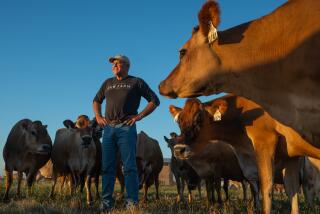Honesty on Mad Cow Risk
Since 1986, about 80 people in Britain have died from the human form of bovine spongiform encephalopathy, or mad cow disease, apparently after eating the meat of infected animals. The problem is not going away. Cattle screenings last year detected the causative agent--a twisted form of a normal protein--in hundreds of cattle in other European countries, provoking near-panic on the Continent.
Most Americans have felt safe from mad cow disease. Last week, however, Food and Drug Administration officials admitted that “hundreds” of U.S. animal feed producers have not properly labeled their products as containing the sort of rendered animal byproducts through which the disease has spread in Europe. Some FDA-licensed feed mills did not have any system to prevent potentially risky byproducts from entering animal feed.
FDA officials also acknowledged the emergence of mad cow disease variants in deer and elk in the West and in an unknown number of American sheep. They say they have sent warning letters to several companies and recalled “some [animal] feed.” On Thursday, they will consider additional safety steps, but the proposed bans on blood donations by people who have lived in Europe or hunted deer and elk just skirt the edges of the problem. The FDA should begin fundamental reforms to close loopholes that, according to a recent European Union report, allow tons of risky European beef products to be shipped to the United States each year for use in health supplements for human use as well as in gelatin, vaccines, collagen and other products.
In 1997, the FDA formally banned mammal proteins from being used in the feed of susceptible animals such as cows. But the FDA allowed farmers to use those proteins in feed for poultry and pigs, and mislabeling and other mix-ups by farmers may have allowed the feed to reach cows and other ruminants.
One solution would be a federal version of legislation introduced in North Dakota last week that bans livestock feed producers from making--and ranchers from using--any feed made with animal bones and spoiled animal parts.
Experts on mad cow disease emphasize that most Americans face an extremely low risk from the disease and that, so far, it has not killed any cattle or people in the U.S. Still, Bush administration officials should avoid issuing false reassurances, remembering the fate of German health and agriculture officials whose own complacency in the 1990s has now brought on their shamed resignations.
More to Read
Sign up for Essential California
The most important California stories and recommendations in your inbox every morning.
You may occasionally receive promotional content from the Los Angeles Times.










